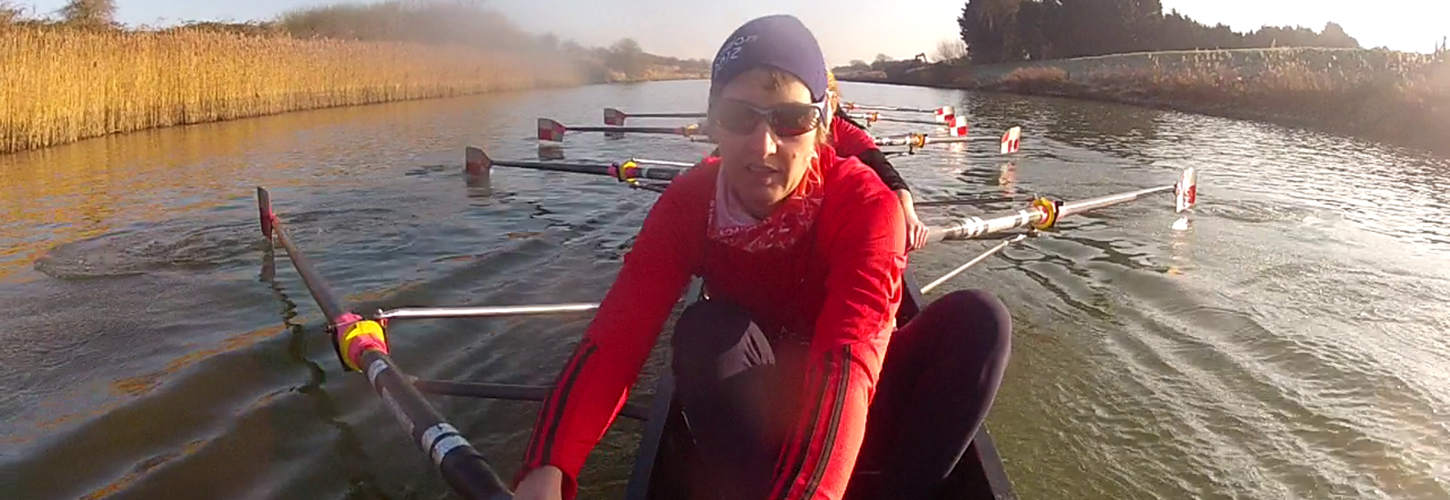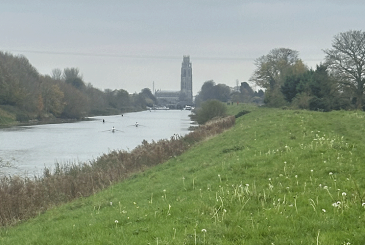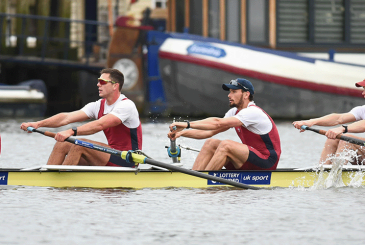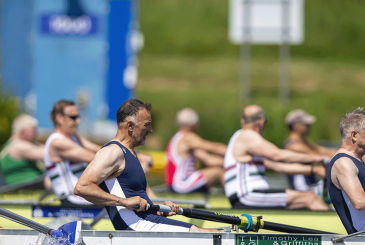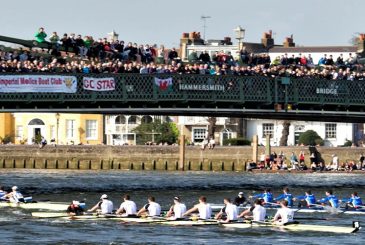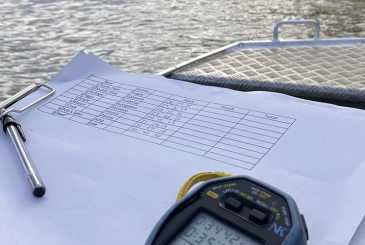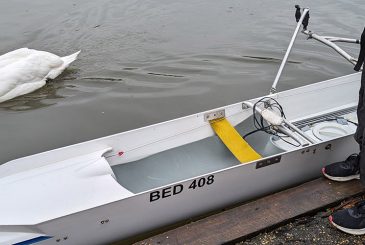While rowers are getting to grips with holding one oar in both hands, rather than a scull in each one, coxes also have a few new commands and techniques to learn if they’ve only coxed quads and octs before.
Note: this article is written for those who have already done some coxing – such as new J15s – and focuses on the differences between coxing sweep crews compared to sculling crews. Our Coxing Workshop for Clubs covers general coxing skills. Coxes starting to cox sweep crews for the first time can learn more about this switch from the rowers’ perspective in our article How to transition from sculling to sweep.
What to call the sides
Correct British Rowing terminology, which is used by umpires during races, is ‘port’ (for rowers whose oar is to their right while rowing), and ‘starboard’ (for rowers whose oar is to their left).
In practice, many people prefer to use the terms strokeside (port) and bowside (starboard). This article uses strokeside and bowside.
When people are learning to row, coaches and coxes often use the terms red (strokeside) and green (bowside). These are easy for beginners to relate to when blades are marked with red and green tape. Red/green are generally not used in sweep rowing, or by more experienced rowers.
The table below summarises these terms:
| Cox’s left/Rowers’ right side | Cox’s right/Rower’s left side |
|---|---|
| Strokeside | Bowside |
| Port | Starboard |
| Red | Green |
Getting the boat out/in and getting in/out of it
| Situation | Command for quad or oct | Command for four or eight |
|---|---|---|
| Getting the boat off the rack | Odd/even numbers going under, ready, lift | Bowside/strokeside* hands across, strokeside/bowside going under, ready, lift *Rowers should be OPPOSITE their rigger when carrying an upside-down boat. Therefore get bowside to go under if the strokeside riggers are pointing towards the rack, and strokeside to go under if the bowside riggers are pointing towards the rack. |
| Getting into the boat | Odd numbers holding/evens get in | Bowside/strokeside* holding, strokeside/bowside get in *The people whose riggers are on the bank/pontoon side should hold the riggers initially while the other side gets in (and gets their blades out) |
| Getting out of the boat | Odd numbers get out and hold the riggers | Bowside/strokeside get out and hold the riggers *The people whose riggers are on the bank/pontoon side should get out first and hold the riggers. Then tell the other side (who have been continuing to balance the boat with their blades on the water) to get out. |
| Putting the boat back on the rack | Odd/even numbers hands across, other people come under | Bowside/strokeside* hands across, strokeside/bowside come under *As the rowers will have carried the upside down boat OPPOSITE their rigger, get strokeside to reach across if the strokeside riggers are pointing towards rack, and bowside to reach across if the bowside riggers are pointing towards the rack. |
Manoeuvring
Straightening up
In an eight, generally use BOTH bow and 3 or 2 and 4 to straighten the boat before starting to row or while marshalling at a race. It’s not fair to ask just one person (bow or 2) to pull a whole eight round because it’s heavy. Also, and a single stroke from one of them won’t make much difference. So it’s better to ask for one stroke from two people, than three strokes from one person.
Similarly, use BOTH stroke and 6 or 7 and 5 to back down if that’s the manoeuvre you want.
In a four, it’s fine (and more stable when the crew is inexperienced) to use just one rower to manoeuvre because the boat isn’t as heavy for them to pull round.
Spinning
I prefer to use an alternate stroke spin in eights and fours, simply because the boat turns round quicker that way. ‘Tap turns’ look cool, but they turn sweep boats slowly.
In training, you will usually turn the boat with strokeside backing and bowside rowing on. On a river, when you’re turning to go downstream, this will pull the bows out into the stream, which will help the boat to turn. When you’re turning to head upstream, before you easy, steer towards the bank you’re turning towards. When you turn, the stream will help push your stern round.
Command: Strokeside take the run off it, strokeside reverse (your blades), alternate stroke spin starting with strokeside backing, go.
Tips: Always start with the side who is backing down as this brings the boat to a complete halt.
Going through narrow bridges
Sweep blades are longer than sculling blades. This means that the total width of a sweep boat from blade tip to blade tip is wider than that of a crew sculling boat. This matters if you regularly go through narrow bridges on the river where you train (or race). If this applies to you, your coach will be able to reassure you that your sweep boat will fit through the arches used for navigating in each direction, but you may need to be more accurate in your steering and ensure you head for the exact centre of the arch of any tight bridges.
The town bridge in Bedford, the ‘tricky arch’ of Elvet Bridge in Durham, and the Middlesex arches of Chiswick and Barnes Bridges on the Tideway when going upstream on the ebb tide are examples that a number of coxes will encounter.
Balance: calls that will help
Balancing a sweep boat requires good timing and consistent, correct body posture from all of the rowers. This can be tricky, so inexperienced sweep crews can often be unbalanced.
Although your coach will be working on the skills that will improve balance, you can also use the following calls (as well as reinforcing what the coach has said) to help improve balance:
- One finish, go.
- Bowside draw up at the finish, strokeside tap down, go (if the boat is down on bowside), or even both sides draw up and tap down, go.
- Send the finishes, go.
If you’re in the stern of a sweep boat, you can also affect the balance by pressing your foot on the side that’s up. However, it’s best to avoid this as the rowers will then feel that the boat is balanced and they won’t realise that they need to adjust what they’re doing, which is the long-term solution that’s needed.
Exercises that will help with balance include single strokes/pauses and square blade rowing (to encourage tapping down fully at the finish).
Sweep-specific exercises
Several exercises that you’ll already be familiar with from sculling crews are also useful in sweep rowing, such as single strokes/pauses, square blade paddling, and working up the slide.
However, there are a few more than you can now add to your toolbox, which are only possible or are much more useful in sweep rowing. Here are three of the most common.
Tip: for any of these exercises to revert to normal rowing, just say “Normal paddling, go”.
1. One side square blades
When rowers row square blades, they tend to send their finish a little more positively, extract the blade more cleanly, and make a clearer circle with their hands at the finish. If one side rows square blades while the other side feathers as usual. The boat will probably go down to the feathering side. This exercises makes the featherers raise their game!
Command: Strokeside, square blades, go (on the catch).
After about 10 strokes, switch sides:
Command: Changing to bowside square blades, strokeside feathering, go.
Do at least 2 sets with one side rowing square blades before you revert to normal rowing.
2. Inside hand down the loom
By placing their inside hand much towards the button, rowers get a clear feeling of how their outside hand draws through and presses down at the finish.
Command: Inside hands down the loom, go.
3. Tap your inside hand on your head on the way forwards
You can do this exercise while paddling continuously or as a variant in single strokes/pauses. It helps rowers to ‘feel the weight’ of the handle correctly in their outside hands.
How it works: Once the rowers has got their arms out straight after the finish (with the blade feathered), they briefly but calmly tap the top of their head with their inside hand before putting it back on the handle and squaring ready for the catch.
Command: Tapping your heads with your inside hands on the way forward, go.
Photo: Helena Smalman-Smith.


